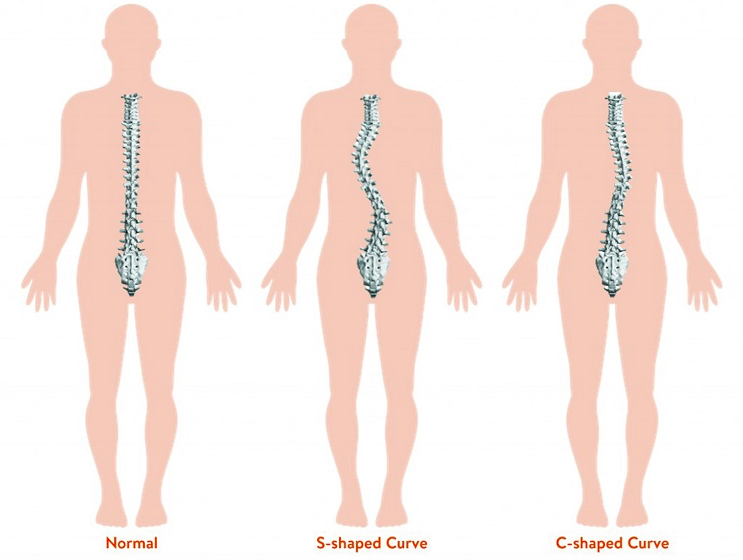Top 5 Ways Adults with Scoliosis Can Get Ahead of the Curve
Scoliosis is an unnatural curvature of the spine, typically in an “S” shape but sometimes taking a “C” shape, that often occurs during growth spurts in children. When children are diagnosed, sympathy and treatment options abound.
Unfortunately, for adults with scoliosis, they often feel ignored, neglected, or even blamed for “not taking care of the problem” when they were younger. Most cases of adult scoliosis occur during the teenage years, although some adults develop it after the age of 18.
The causes of adult scoliosis are very different than the ones that cause childhood scoliosis. While many cases are “idiopathic,” meaning the cause is unknown, other causes are congenital, or due to myopathic or due to a paralytic curve. Some causes are secondary, which is to say that there is another spine condition which is affecting the vertebrae, which allows the spine to curve unnaturally. Scoliosis in adults sometimes forms after spine surgery.
More Adults Than Children Have Scoliosis
It’s interesting to note that while most people are aware of childhood scoliosis, adult scoliosis is almost unheard of. This painful condition affects only 2 or 3 percent of all children but as much as 30 percent of adults! Many experts believe that this condition will increase over the next few decades as people live longer and develop other spinal issues, such as spinal degeneration, which can lead to scoliosis.
One Persistent Myth
While adults often suffer from more pain, loss of function, and fatigue than their junior counterparts, one myth prevails- Nothing short of surgery can help.
This is simply not true.
The truth is that when health care professionals, such as chiropractors, treat the underlying cause of scoliosis, there are tremendous improvements in every area!
While braces can be effective tools for straightening the spine in childhood, after adulthood, the spine cannot be forced back into a normal position. Braces are often helpful ways of reducing pain, but they won’t do much else.
For those who are interested in other methods besides or in addition to braces that can reduce pain, improve flexibility, increase range of motion, slow the progression of scoliosis, and more, we have compiled a list of effective treatment methods that can improve your overall quality of life.
Top 5 Non-Surgical Means of Improving Adult Scoliosis
It’s interesting that when I talk to adults about their scoliosis, they are surprised to find that chiropractic care and other treatment methods can reduce their pain and improve their posture.
#1 Exercise/Rehabilitation Therapy
For those whose curve is still within a manageable range, certain exercises and rehabilitation techniques have an excellent record of reducing pain and strengthening muscles that have become stiff or weak.
Most of the exercises will focus on improving back and core muscles to improve support of the spine. Other muscles, however, are often neglected, such as the legs or arms, when it causes patients pain to move. After a full exam and consultation, your chiropractor will explain where your weaknesses lie and the proper treatment/exercise plan they have devised especially for you, to help improve your symptoms.
#2 Vibration Therapy
Unfortunately, some patients are in so much pain, they can’t perform the exercises listed above. For those individuals, I recommend whole body vibration therapy to begin with. This is actually a great therapy for nearly everyone, but especially for those who find exercise too painful.
Whole body vibration boards are available at nearly all sporting goods stores or online. Vibration boards look like a short, fat balance beam with motor attached to the bottom. You can adjust the strength of the vibration with a dial. Just 10-12 minutes each day will strengthen both bones and muscles, as well as offering some mild pain relief.
Nearly all professional athletes use vibration boards as part of their work-out routines because they know that, for reasons we don’t understand, vibrations within a certain range build stronger muscles and make bones denser. Don’t take our word for it- you can read about what Harvard says about vibration boards here.
#3 Comprehensive Chiropractic Care
Chiropractors are highly skilled and have extensive knowledge in all things to do with the spine, the muscles, and the connective tissue. It only makes sense that, for adults with scoliosis, seeing a chiropractor who can perform adjustments on the spine, will eliminate pressure on the nervous system, which is one cause of intense pain.
In addition to adjustments, your chiropractor will most likely use a variety of modalities, depending on the severity of your scoliosis and/or its location. Other modalities include non-surgical spinal decompression machines, TENS units to stimulate the muscles, or foam blocks for spine molding.
Chiropractic care is very effective for adults with scoliosis, as this study has shown. Out of the 28 patients in this study, the Cobb angle was reduced for 22 subjects and pain levels were lower, even 6 months after the study had ended.
Don’t be surprised to discover that, after a few chiropractic visits, in addition to feeling better in general, those frequent headaches disappear, you don’t catch nearly as many colds or the flu, other joints besides your back stop hurting and more. This article explains how and why this happens.
#4 Massage Therapy
Nearly all chiropractors offer massage therapy and with good reason! Massage therapy has numerous benefits besides making you feel good. Massage reduces the chronic back pain and help to balance the muscles between back and body.
Of course, massage won’t “cure” scoliosis, but as an additional treatment (often used either before or after chiropractic adjustments) massage therapy can provide temporary relief from scoliosis pain and other scoliosis symptoms.
#5 Nutritional Supplementation
Depending on your particular circumstances, your chiropractor will suggest some nutritional supplements to help improve your symptoms and address some of the underlying causes, if any.
Supplements that might be suggested include calcium, vitamin D, fish oil, magnesium, and/or natural anti-inflammatories to relieve pain, such as curcumin and green tea extracts.
If you found this article helpful, please feel free to share it with family, friends, or on social media sites.
About Dr. Brent Wells
Dr. Brent Wells has been a trusted chiropractor and the #1 Wasilla Chiropractor since moving his family from Oregon to Alaska and founded Better Health Chiropractic Wasilla AK– B.S. from Univ. of Nevada, Doctorate from Western States Chiropractic College, volunteer for Reflex Sympathetic Dystrophy Foundation, and member of the American Chiropractic Association. As a chiropractor, his focus is on family, including his 3 children and wife of 20+ years, his clinics, and ongoing education.


















